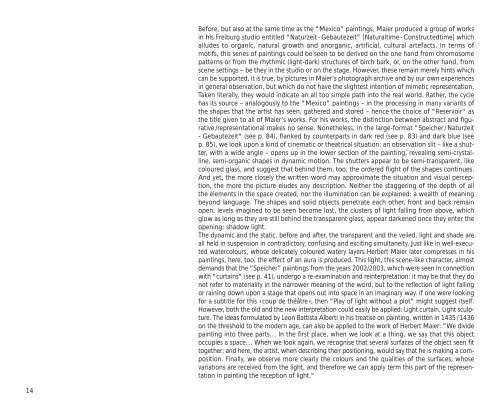Sie wollen auch ein ePaper? Erhöhen Sie die Reichweite Ihrer Titel.
YUMPU macht aus Druck-PDFs automatisch weboptimierte ePaper, die Google liebt.
14<br />
Before, but also at the same time as the "Mexico" paintings, Maier produced a group of works<br />
in his Freiburg studio entitled "Naturzeit - Gebautezeit" [Naturaltime - Constructedtime] which<br />
alludes to organic, natural growth and anorganic, artificial, cultural artefacts. In terms of<br />
motifs, this series of paintings could be seen to be derived on the one hand from chromosome<br />
patterns or from the rhythmic (light-dark) structures of birch bark, or, on the other hand, from<br />
scene settings – be they in the studio or on the stage. However, these remain merely hints which<br />
can be supported, it is true, by pictures in Maier’s photograph archive and by our own expe riences<br />
in general observation, but which do not have the slightest intention of mimetic representa tion.<br />
Taken literally, they would indicate an all too simple path into the real world. Rather, the cycle<br />
has its source – analogously to the "Mexico" paintings – in the processing in many variants of<br />
the shapes that the artist has seen, gathered and stored – hence the choice of "Reservoir" as<br />
the title given to all of Maier’s works. For his works, the distinction between abstract and figura<br />
tive /representational makes no sense. Nonetheless, in the large-format "Speicher / Naturzeit<br />
- Gebautezeit" (see p. 84), flanked by counterparts in dark red (see p. 83) and dark blue (see<br />
p. 85), we look upon a kind of cinematic or theatrical situation: an observation slit – like a shutter,<br />
with a wide angle – opens up in the lower section of the painting, revealing semi-crystal -<br />
line, semi-organic shapes in dynamic motion. The shutters appear to be semi-transparent, like<br />
coloured glass, and suggest that behind them, too, the ordered flight of the shapes continues.<br />
And yet, the more closely the written word may approximate the situation and visual perception,<br />
the more the picture eludes any description. Neither the staggering of the depth of all<br />
the elements in the space created, nor the illumination can be explained: a wealth of meaning<br />
beyond language. The shapes and solid objects penetrate each other, front and back remain<br />
open, levels imagined to be seen become lost, the clusters of light falling from above, which<br />
glow as long as they are still behind the transparent glass, appear darkened once they enter the<br />
opening: shadow light.<br />
The dynamic and the static, before and after, the transparent and the veiled, light and shade are<br />
all held in suspension in contradictory, confusing and exciting simultaneity. Just like in well-executed<br />
watercolours, whose delicately coloured watery layers Herbert Maier later compresses in his<br />
paintings, here, too, the effect of an aura is produced. This light, this scene-like character, almost<br />
demands that the “Speicher” paintings from the years 2002/2003, which were seen in connec tion<br />
with "curtains" (see p. 41), undergo a re-examination and reinterpretation: it may be that they do<br />
not refer to materiality in the narrower meaning of the word, but to the reflection of light falling<br />
or raining down upon a stage that opens out into space in an imaginary way. If one were looking<br />
for a subtitle for this « coup de théâtre », then "Play of light without a plot" might suggest itself.<br />
However, both the old and the new interpretation could easily be applied: Light curtain, Light sculpture.<br />
The ideas formulated by Leon Battista Alberti in his treatise on painting, written in 1435 / 1436<br />
on the threshold to the modern age, can also be applied to the work of Herbert Maier: "We divide<br />
painting into three parts… In the first place, when we look at a thing, we say that this object<br />
occu pies a space… When we look again, we recognise that several surfaces of the object seen fit<br />
together; and here, the artist, when describing their positioning, would say that he is making a composition.<br />
Finally, we observe more clearly the colours and the qualities of the surfaces, whose<br />
variations are received from the light, and therefore we can apply term this part of the representation<br />
in painting the reception of light."


